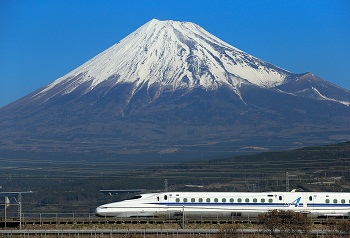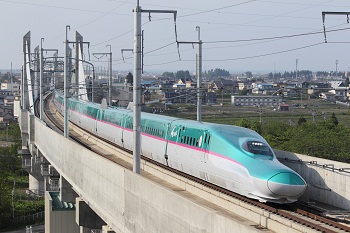Half a century ago, on 10 October 1964, Tokyo held the Opening Ceremony for Japan’s first-ever Olympic Games, which was conducted under an absolutely cloudless blue sky. A few days before that memorable event, another historical moment had been engraved in people’s memories. On 1 October 1964, the world’s first high-speed rail service, the Shinkansen, commonly known as the “bullet train”, had been launched between Tokyo and Osaka.
|
The idea of the Shinkansen was originally conceived to solve the problem of capacity shortage caused by the increasingly strong demand for rail travel in line with Japan’s rapid economic growth. By the early 1960s, capacity on the Tokaido Main Line, which connected Osaka with Tokyo, had reached its limit. Every day a number of express trains ran between the two cities, and filling the intervals between them were numerous freight trains and local passenger trains.
The situation required change, and the plan for change envisaged a new, separate track built to the international standard gauge dedicated to high-speed trains. This track would be the Shinkansen. (The word shinkansen means “new mainline”.) |
|
The plan, approved by the Diet in March 1959, called for the new system to be completed within just five years – in time for the 1964 Tokyo Olympic Games. This was despite the lofty aim of achieving speeds exceeding 131mph, something the world had never before witnessed in rail travel. At the time, the concept was dubbed “the dream super limited express”. The futuristic team at Japan National Railways (JNR) transformed that dream into reality by launching the Series 0 Shinkansen trains, just nine days before the Olympic Games.
Since the inception of its operations in 1964, the Shinkansen has played a vital role in accelerating Japan’s progress towards advanced industrialization. We ourselves have witnessed the Shinkansen’s enormous contribution to the growth of Japan in connecting people and businesses and impacting on our everyday lives. As the country’s economy developed, Japan’s high-speed rail network continued to expand. The length of the Shinkansen line in 1964 was 515km. Today, the line has been extended to 2388km and continues to grow. In March 2015 construction of the Hokuriku Shinkansen connecting Nagano and Kanazawa will be completed and the network will thus be extended by another 228km. Continuous improvements have also been recorded in terms of speed. At first, trains running up to 131mph took four hours to travel between Tokyo and Osaka, but today, with the latest Series N700 trains, the journey time has been cut to two hours and twenty-five minutes. The fastest commercial operating speed of the Shinkansen is now 200mph with the Series E5 trains, which run in the Tohoku region.
|
For fifty years, the Shinkansen has carried over 10 billion passengers with an impeccable safety record of “zero passenger fatalities”. This safety record has never been blemished – not even when the devastating earthquake and tsunami hit the Tohoku region in March 2011. At the moment the disaster struck, 27 Shinkansen trains were in operation in the region, two of which were running at 168mph. However, due to the early earthquake detection system, trains were immediately and safely halted. Meanwhile, punctuality is another phenomenal feature of the Shinkansen. Despite the frequency of the services, the average delay per trip, including weather-related delays, is under one minute. Thus the highest standards of safety and reliability are the hallmarks of Japan’s high- speed railway system.
|
 The Series N700
The Series N700 |
Here in the UK, the Shinkansen’s technology and design can be discerned in the Hitachi-built “Javelin” trains, which during London 2012 swiftly carried hundreds of thousands of spectators from St Pancras to the main site of the Olympic Games at Stratford. Hitachi is one of the most trusted companies involved in the construction of Shinkansen train in Japan. Safety and reliability are thus assured for its Javelin trains. Japan’s first knowledge of railways came from the UK about 150 years ago, and Japan’s railways have developed from the roots of that transfer of knowledge. Today, the flow of knowledge and productive interaction between the two countries in this sector is still flourishing.
|
 The Series E5
The Series E5 |
Coincidentally, on 17 October 2014, fifty years after the introduction of the bullet train, the Japanese Minister of Land, Infrastructure, Transport and Tourism approved plans for the construction of the Chuo Shinkansen between Tokyo (Shinagawa Station) and Nagoya, featuring for the first time the Superconducting Maglev.
This train uses completely new technology to levitate 10cm above the ground, reaching speeds of up to 311mph. In 2027, after the line’s completion, passengers will be able to travel from Tokyo to Nagoya in only forty minutes, compared to the present time of one hour and twenty-eight minutes.
|
High-speed rail in Japan has been a resounding success and has changed the way people live. Its 50th anniversary is a time for celebration during an ongoing journey. The Shinkansen will continue to go from strength to strength. |
|

